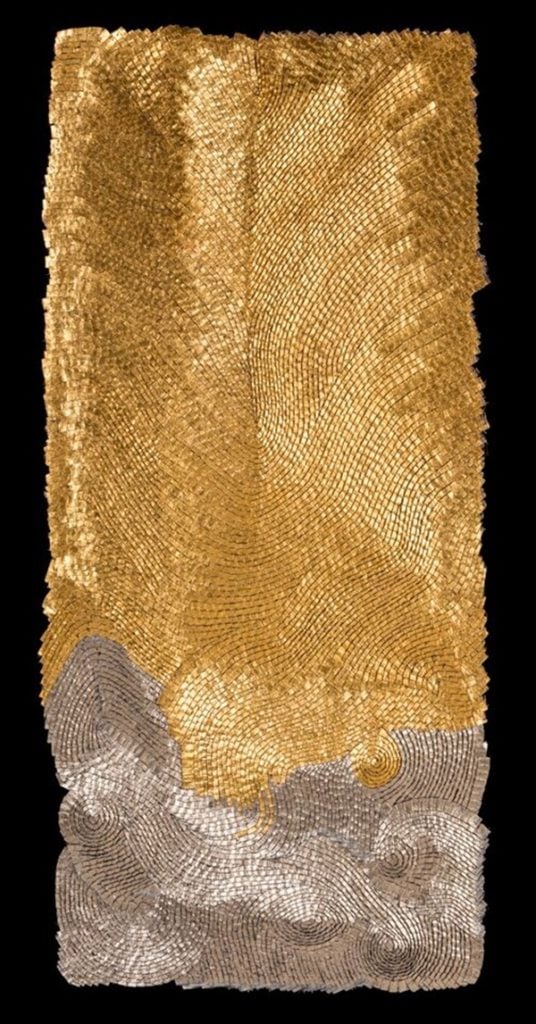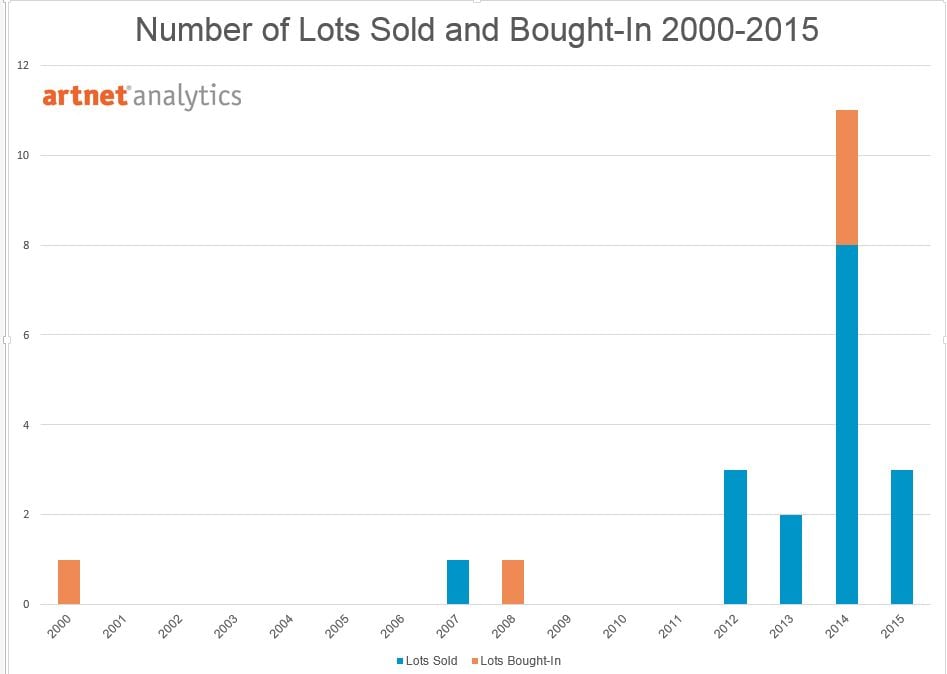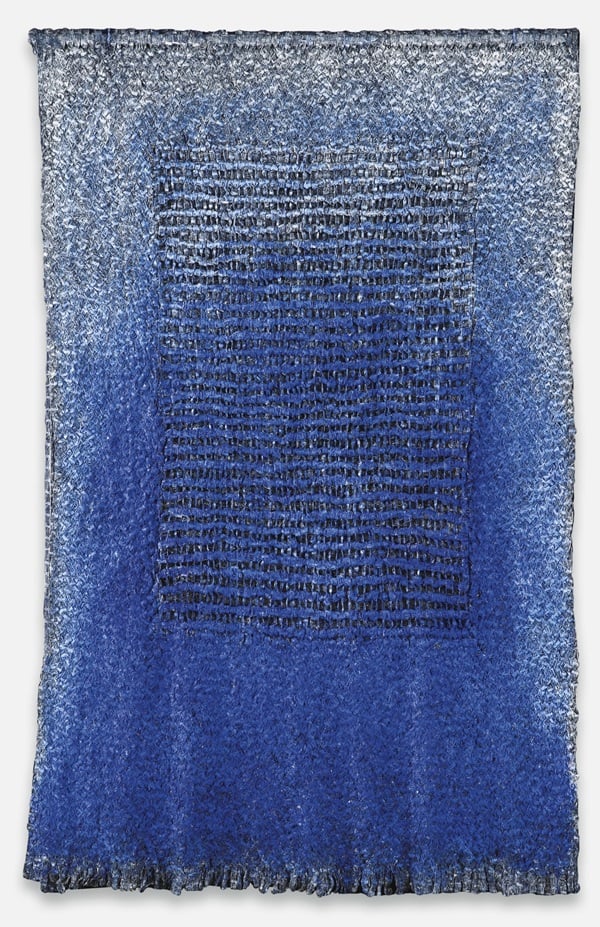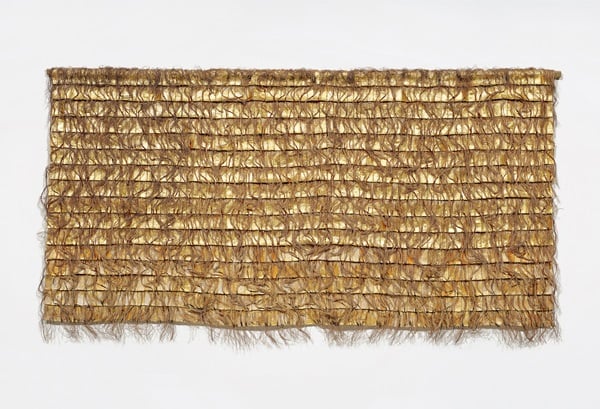Art Fairs
Gold Rush For 83-Year-Old Artist Olga de Amaral’s Seductive Weavings
Another senior woman artist is finally getting her due.

Another senior woman artist is finally getting her due.

Eileen Kinsella


Olga de Amaral, Sol Rojo Doble (2013).
Image: Courtesy of Agnes Monplaisir, Paris.
Eighty-three-year-old Colombian artist Olga de Amaral (b. 1932) is widely recognized for the beauty and originality of her rich, textural, innovative artworks combining fiber, paint and gesso, along with found objects, precious metals and other materials.
But it is only in recent years that the art market and collectors have woken up to the long-term monetary value of her work. Auction records support the view that prices are moving up—fast.
“The demand, or rather in my mind the appropriate term would be ‘desire’ for Olga’s art has always been strong,” says Paris dealer Agnes Monplaisir, a long term and tireless promoter and fan of de Amaral’s art. “But I have seen an astonishing increase in interest and sales in the past few years,” she says.
Monplaisir shows de Amaral’s work at virtually every international art fair she participates in. She also personally buys and hangs the work in her many homes. That’s how much she believes in the artist.
“Every day, whether it is in my gallery in Paris, via emails, or at the fairs, I am contacted about Olga at an impressive rate— there are so many requests for pricing, further information, catalogues. I even have other important galleries presenting proposals, either directly to Olga or myself.”
Sales data supports this increase in interest. Prices have risen to four times what they were in just ten years and will continue to increase, it would seem, since the demand is greater than supply. One reason for this imbalance is that de Amaral’s artwork takes a lot of time to complete as the artist works very slowly and carefully.

Works at auction by Olga de Amaral 2000–2015.
Source: artnet Analytics
Things in the market have however changed fast. Until recently auction results for Olga de Amaral were extremely sparse (and completely non-existent in some years), with the artnet price database listing 22 sales. But the closer you get to the present the more sales there are and the prices per sale are increasing too: the current record at auction, of $245,000 achieved at Sotheby’s in November 2014 for Sombra Azul (1989), was roughly double the $120,000 high estimate.

Olga de Amaral’s Sombra Azul (1998) sold for $245,000 at Sotheby’s in November 2014, the highest price at auction for the artist to date. (Estimate: $80–120,000).
Image: Courtesy of Sotheby’s.
Phillips head of Latin American art sales Kaeli Deane told artnet News: “Because of her age, it’s easy to think that her pieces should have been coming up at auction for a long time now, whereas in reality most of the sales have been relatively recent. That’s primarily because she’s really a contemporary artist. If you look at the years of the works that have been sold, they’re mostly from the 1980s, 1990s, and 2000s.”

Olga de Amaral’s Alquimia XIX (1985) sold at Phillips in November 2014 for $68,750 on an estimate of $50–70,000.
Image: Courtesy Phillips
Deane points out that the Latin American auction market, which only got started in the early 1970s, was primarily focused on modern art. A recent trend, which she says Phillips “pioneered”, is “that area of looking at Latin American art through a contemporary lens as opposed to a modern painting one.”
De Amaral, who lives and works in Bogotá, studied fiber art at the Cranbrook Academy of Art in Michigan from 1954–55. She later became the director of the textiles department at the University of the Andes in Bogotá and was awarded a Guggenheim Fellowship in 1973. In 2005, she received the “Visionary Artist” award from the Museum of Arts and Design.
A further shift, Deane notes, which has also boosted interest in de Amaral’s work, is a newly heightened focus on Latin American abstraction.
Last month, Sotheby’s opened its Latin American art auction series with a special sale titled “Latin America: The Legacy of Abstraction,” that featured artists such as Mira Schendel, Carlos Cruz-Diez, and Joaquin Torres-Garcia, and realized $6 million in total. The sale included a work by de Amaral, shown below, Lienzo Ceremonial 11 (1989), that sold for $125,000, doubling the high end of the $40,000 to $60,000 estimate.

Olga de Amaral’s
Lienzo Ceremonial II (1989) sold for $125,000 at Sotheby’s last month (Estimate: $40–60,000).
Image: Courtesy of Sotheby’s.
Other recent six-figure sales include, in May 2014, at Bonhams, a gesso on gold leaf with fiber triptych, Triptico en Oro (1992), that went for $173,000 and importantly was included in their contemporary art sale (estimate: $140–180,000). And in May 2014, at a Christie’s New York Latin American art sale, Cesta Lunar 016 (1992) sold for $161,000, clearing the $150,000 estimate.
“Colombians have known about her work for decades,” said Sotheby’s vice president of Latin American art Anna Di Stasi, in a phone interview. “While they were supportive, they were never truly at the level of buying at the prices that we have seen at auction recently.”
Di Stasi also said de Amaral benefits from a new interest in textile-based art practices. “A lot of textile-based contemporary artists have come to the forefront now. I think collectors are looking at her work more seriously as opposed to thinking of it as a type of decorative wall hanging or craft, especially in Latin America.”
Deane agrees with this assessment but also points to the historical significance of the colors and materials the artist uses. “Within her work, the gold actually has historical significance, relating to pre-Hispanic/pre-Colombian art as well as colonial Latin American art, both of which incorporate gold.”
Her most popular works tend to be the large, gold, monochromatic ones, which Di Stasi describes as having a “spiritual” quality. Prices on the private gallery sales side, especially for these gold works, tend to be higher than at auction. Not surprisingly this is where many recently executed works tend to be sold.
Monplaisir says that she sells a lot of de Amaral’s work privately for prices “in excess” of auction records but adds that they tend to be large, impressive pieces so very much in line with overall pricing.
“Simply put her art is remarkably powerful,” Monplaisir says “and collectors want it. Olga’s evolving technique and use of non-traditional materials has transformed the art of two-dimensional textiles and tapestry making into three-dimensional, abstract art.”
For more market analysis coverage see:
New Buyers Fuel Demand and Double Estimates at Latin American Art Auctions
Jesus Rafael Soto and Kinetic Art Storm The Market
Frida Kahlo Market Booming Despite Tough Export Restrictions